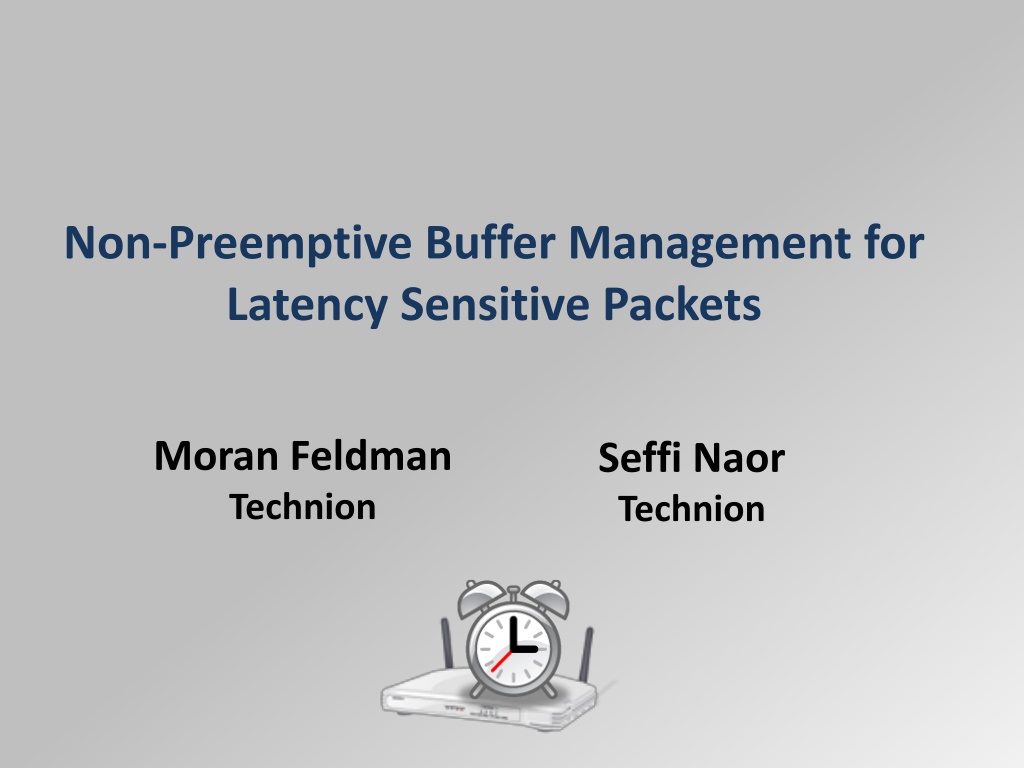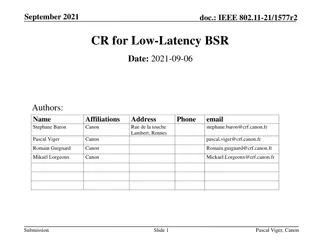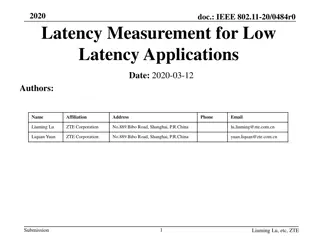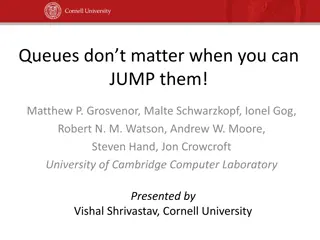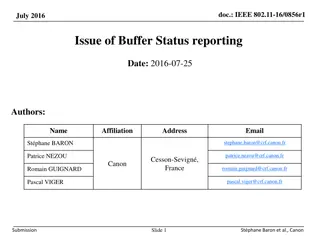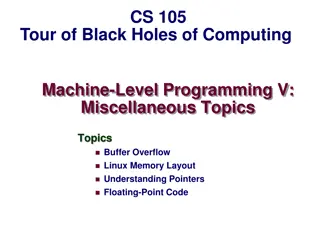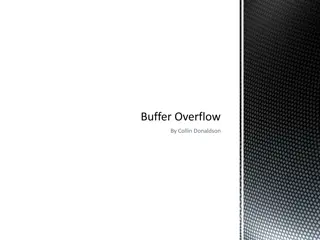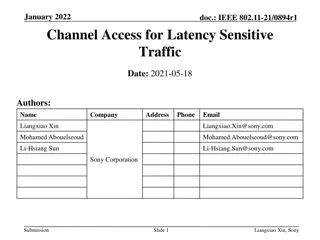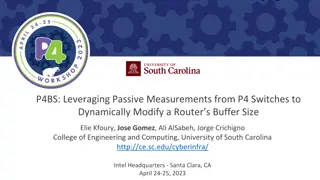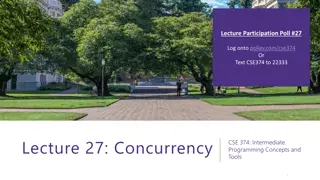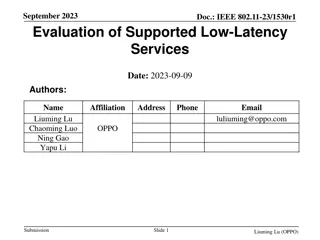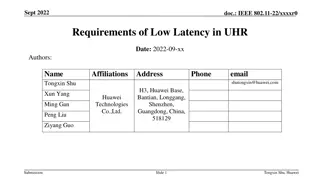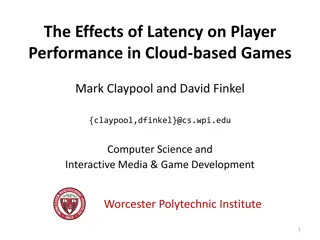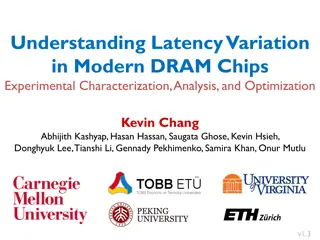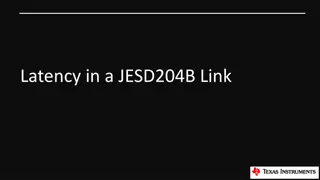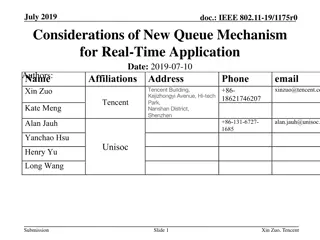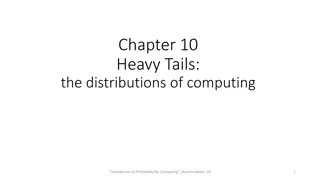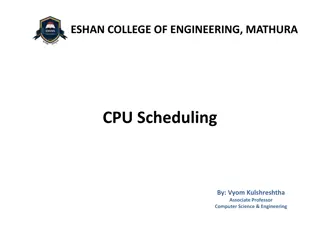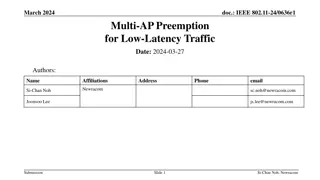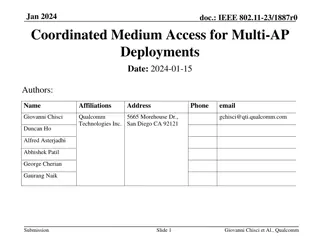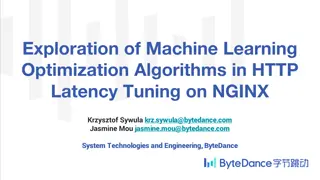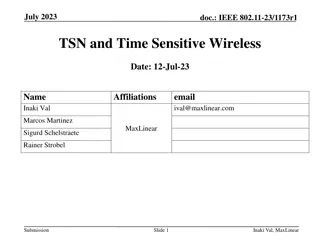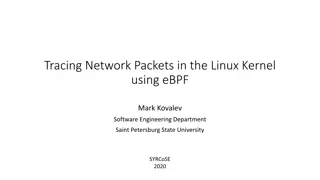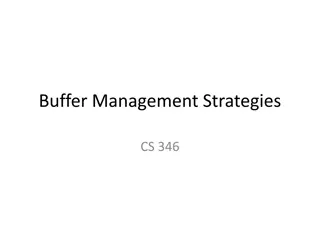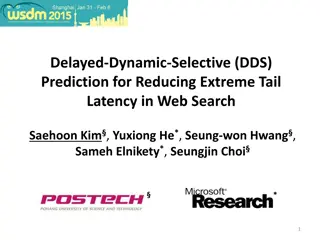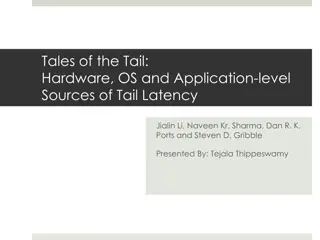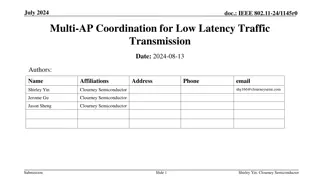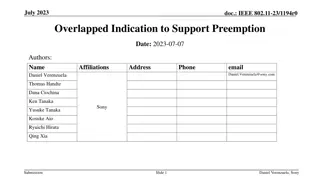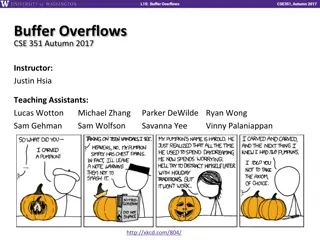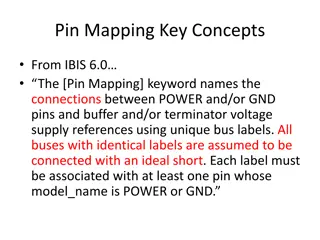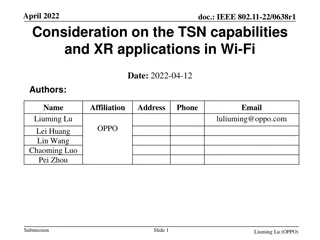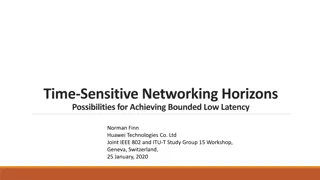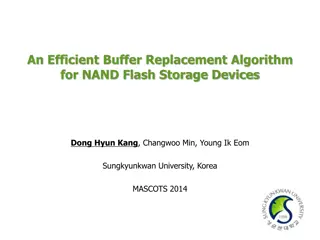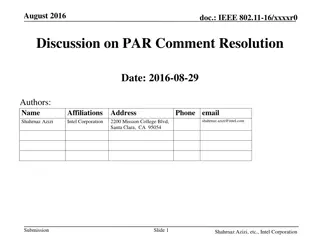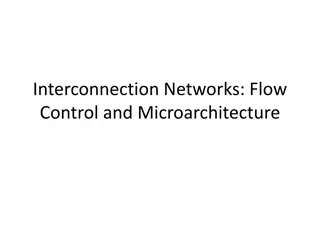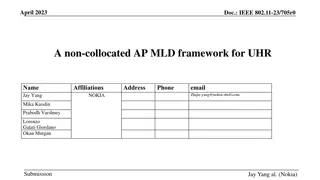Non-Preemptive Buffer Management for Latency Sensitive Packets
Moran Feldman and Seffi Naor from Technion present a non-preemptive buffer management approach for handling latency-sensitive packets in communication networks. The model focuses on deadlines for packet arrival and associated values that diminish over time. The competitive ratio is used as a performance measure for online algorithms, with known and new results discussed for different packet models. A lower bound is established for the unrestricted model, showing that certain algorithms are not c-competitive.
Download Presentation

Please find below an Image/Link to download the presentation.
The content on the website is provided AS IS for your information and personal use only. It may not be sold, licensed, or shared on other websites without obtaining consent from the author. Download presentation by click this link. If you encounter any issues during the download, it is possible that the publisher has removed the file from their server.
E N D
Presentation Transcript
Non-Preemptive Buffer Management for Latency Sensitive Packets Moran Feldman Technion Seffi Naor Technion
Outline Model and motivation Prior art and our results Focusing on results: Lower bound for Unrestricted Model Deterministic algorithm for Integral Valued Model Randomized algorithm for Real Valued Model Open problems 2
Motivation Consider a path in a communication network: Router Router Router A packet going through the path often has a deadline. The deadline refers to the arrival of the packet to its destination. An online model of a router must deal with these deadlines: Traditional models assume a deadline for leaving the router. A new model (proposed by Fiat, Mansour and Nadav [SODA 2008]), associates each packet with a value that diminishes over time. 3
The Model Our model is based on the model of Fiat et. al. 3 4 2 Router s queue Packets Time Unlimited size Arrive online, each has an associated value w(d). Must be rejected or accepted immediately. Packets arrive at fractional times and are transmitted at integral ones. At each integral time the first packet of the queue is transmitted. Its revenue is w(d) minus the delay it suffered in the queue. Continues, starting at time 0 4
Competitive Ratio Standard performance measure for online algorithms. Notation I An instance of an online problem. ALG(I) The value of an online algorithm ALG on I. OPT(I) The value of the optimal offline algorithm on I. For Deterministic Algorithms For Randomized Algorithms ( ) ( ) I ( ) ( ) I OPT I OPT I sup sup ALG E ALG I I Against oblivious adversary. Other adversary types also exist. Randomization often improves the achievable competitive ratio. 5
Known and New Results Sub models Unrestricted model A packet can have any positive value. Real valued model A packet can have any value 1. Integral valued model A packet can have any positive integral value. Unrestricted Model Model Unrestricted Real Valued Model Model Real Valued Integral Valued Model Valued Model Integral 3 4.236 (3) Lower bound Lower bound (3) 3 3 4 (3) 3 Deterministic Deterministic Upper bound Upper bound - - 4.24 4.24 4.24 4 (4.24) Lower bound Lower bound 1.618 ( ) 1.618 4 ( ) 1.618 4 ( ) Randomized Randomized Upper bound Upper bound - - 4.24 4 (4.24) 4.24 4 (4.24) Known results inferred from Fiat et. al. New results appear in red. 6
Unrestricted Model Lower Bound Consider any algorithm ALG and a constant c. Our job: Show that ALG is not c-competitive. Plan of Adversary 1. For i = 1 to 2c do: 2. Give ALG a packet of value (1/2c)2c+1-i. 3. If the probability that ALG accepted any packet, so far, is less than i/2c, terminate. 4. Give ALG a packet of value 1. Proof Idea Packets have exponentially increasing values, but all values are at most 1, so only one packet gives revenue. ALG must accept each packet with some probability. OPT accepts with probability 1 the last packet. 7
The Dual-Fitting Method Offline Primal Program ( ) t d y d a t , ( ( ) ( ) ) ) t ) ( ) max w + , d d ( ) d ( ) ( ( ) ( d y a d + | d t a t w d a ( ( ) . t . s 1 packet constraint y d a t d ( ) d ( ) d + | t a t w d ) , 1 constraint time t ( ) ( d ( ) ( ) d , | d a d t w ) ( ) d ( ) d ( ) d + 0 , y t d a t w a y(d,t) Indicates whether packet d was transmitted at time t. w(d) The value of packet d. a(d) The time when packet d arrived. Remark The LP contains no FIFO constraint because this is no constraint from the offline point of view. 8
The Dual-Fitting Method (cont.) Offline Dual Program + min x z t d t d ( ) d ( ) d ( ) d ( ) d ( ) d + + . t . s , x z w 0 t a d a t w a t d , , x z d t t d Method Every dual solution is an upper bound on OPT. To show that an algorithm is c-competitive we do the following: Consider any input sequence . Calculate the revenue R of the algorithm on . Find a dual solution of value D for . Prove that D /R c. 9
Deterministic Reduction to Simple Inputs Definition An input sequence is simple if all packets in it arrive before time 1. Reduction If there is a deterministic R-competitive algorithm A on simple input sequences, then there exists a deterministic R-competitive algorithm B on all input sequences. Definition of B B s Input: 5 3 7 A s Input: 5 3 8 0 1 2 3 4 5 1. B simulates A and maps each input packets to A s input. 2. Map each packet to time before time 1, and increase its value by the number of transmissions so far. 3. Reset the algorithm when the queue empties. 10
Deterministic Reduction to Simple Inputs (cont.) Why Does It Work? Let an interval be the time between two consecutive resets. B (and A) transmit packets at all integral times in an interval. Moving packets to earlier time: Does not effect the transmission times. Increase the delay that the packets suffer. Increasing the value of the packets counter the additional delay. 5 3 7 5 3 8 0 1 2 3 11
Deterministic Algorithm for Integral Simple Inputs Algorithm (NDT) 1. Let Qbe the number of packets in the router s queue. 2. Accept a new packet d if and only if w(d) 2Q + 1. Remark The algorithm also works for general integral inputs, although it is more difficult to show that. Reduction Assume that if a packet d is accepted, then its value is exactly 2Q+1. Proof This is the lowest value that will get the packet accepted. 12
Analyzing NDT Assume k packets have been received: Value for the Algorithm Assignment to the Dual LP ( ) + + + min 2 x z 1 1 k = k k k k ( ) t d + = = 2 1 Q Q t d ( ) d ( ) d ( ) d ( ) d ( ) d + + . t . s , x z w 0 t a d a t w a 2 2 t d 0 Q , , x z d t t d zd = 0 xt = max{2k - t, 0} ( k k = 2 ) Delay Packet Value 2 1 2 2 1 k Value of solution: ( ) = = 2 2 2 k t k k 1 t k 2 The competitive ratio of NDT is: 2 k k 4 ( ) + 2 / 2 k 13
Randomized Reduction to Simple Inputs Difficulty The previous reduction does not work for randomized algorithms: If we restart each time the queue empties, the simulated algorithm A will face a non-oblivious adversary. If we do not restart, the algorithm will not necessarily have a packet to send at each integral time of an interval. Definition A randomized algorithm is good if at all times an external observer can give a number P such that: The algorithm has either P or P+1 packets in its queue. P does not depend on the random decisions of the algorithm. Remark In a sense, a good algorithm is a randomized algorithm with minimal randomness. 14
Randomized Reduction to Simple Inputs (cont.) Objective Make the previous reduction work for good randomized algorithms. Idea We reset A s simulation after every integral time in which we might not have a packet to transmit. This ensures that the queue is empty after every reset. Either: The queue was empty before the integral time. The last packet was sent during the integral time. A faces an oblivious adversary. The reduction does not depend on A s randomized decisions. The algorithm transmits at each integral time between resets. 15
Randomized Algorithm for Real Valued Simple Inputs Algorithm (RNDT) 1. Let Q be a random variable of the size of the queue. 2. Keep the invariant Q = E(Q) or Q = E(Q) . 3. Accept a new packet d with probability: d first packet w(d) 2E(Q)+0.5 2E(Q)+0.5 w(d) 2E(Q)+2.5 w(d) 2E(Q)+2.5 0 w(d) / 2 0.25 E(Q) 1 To keep the invariant, true acceptances probability depends on the random variable Q. Reduction Let Ef be the final value of E[Q]. No packet had value over 2Ef + . Proof Implied by the acceptance probabilities. 16
Analyzing RNDT Value for the Algorithm Assignment to the Dual LP E + / 1 + + 2 f 4 E E 1 min x z f ( ) + t d f 5 . 0 + = x dx t d ( ) d ( ) d ( ) d ( ) d ( ) d + + . t . s , x z w 0 t a d a t w a 2 2 t d / 1 2 , , x z d t t d zd = 0 xt = max{2Ef + 1.5 - t, 0} ( 2 5 . 1 + t ) 2 A packet of value 2E[Q]+0.5+ is accepted to extent. First Packet 5 . 1 + 2 1 E E ( ) f = t Value of solution: f = 2 E f 2 1 E = + / 1 + 2 f 2 2 2 E f + E / 1 + 2 f 2 E 2 2 E E The competitive ratio of RNDT is: ( f = 4 ) + / 1 + 2 f 4 / 2 f 17
Open Problems Adversary that draws from a malicious distribution. Competitive analysis provides too pessimistic a view. Classic queuing theory analyzes Poisson distributed source. Provides a middle ground between the two approaches. A sub-model where all values above some constant c are allowed. Generalizes the unrestricted and real-valued models. The constant c represent the ratio between the shortest deadlines and the speed of the network. The main question is finding the relation between c and the competitive ratio. 18
